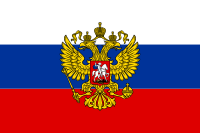Supreme Commander–in–Chief
Thus, the provision on field command and control of troops in wartime provided that "The supreme command over all land and naval forces intended for military operations shall be entrusted to the Supreme Commander–in–Chief, if the sovereign does not deign to lead the troops personally" (Article 6), such was appointed "by direct the election of the sovereign "(that is, independently by the Emperor, and not by anyone's recommendation) by the highest order and decree of the Senate.[4] Not recognizing that it is possible, for reasons of a general state nature, to become now at the head of our land and sea forces intended for military operations, we recognized for the benefit of all the most merciful order to our Adjutant general, Commander–in–Chief of the Guards and the Petersburg Military District, General of Cavalry, His Imperial Highness the Grand Duke Nikolai Nikolaevich to be the Supreme Commander–in–Chief.During the First World War, this position was held by: In connection with the reorganization of the management of the army and navy, after the signing of the Brest Peace Treaty by the Bolsheviks, the post of the Supreme Commander–in–Chief was abolished.In accordance with the governing documents of that period, the Supreme Commander–in–Chief controlled only the active army and navy.After the arrest and execution of Kolchak, the Supreme Command formally passed to Anton Denikin.4061–I "On Amendments and Additions to the Constitution (Basic Law) of the Russian Federation – Russia" dated December 9, 1992,[10] which entered into force from the moment of publication in the "Rossiyskaya Gazeta" on January 12, 1993.This title formally became obsolete in 1947 when a new democratic constitution took effect and the Imperial Japanese Armed Forces were abolished.The Supreme Commander of the Korean People's Army is the Chairman of the Central Military Commission of the Workers' Party of Korea.He is the one who declares war and concludes peace, in addition to appointing the highest military and security ranks in the state.





armed forcescoalitiontheater of military operationshead of stateCharles IBritish CommonwealthGovernor–GeneralPrzemyslNikolai KrylenkoAll–Russian EmperorBasic Laws of the Russian Empirenaval armed forcesdefensestrongholdsmartial lawtheater of operationsarmisticeGrand DukeNikolai Nikolaevich Juniorsea forcesmilitary operationsAdjutant generalGuardsPetersburg Military DistrictGeneral of CavalryFirst World WarNicholas IIabdicationInfantry GeneralMikhail AlekseevCavalry GeneralAlexei BrusilovLavr KornilovLieutenant generalAlexander LukomskyVladislav KlembovskyProvisional GovernmentAlexander KerenskyNikolay DukhoninEnsignBrest Peace TreatyBolsheviksCorner stampJoachim VatsetisSergey KamenevCommander–in–ChiefVasily BoldyrevAdmiralAlexander KolchakAnton DenikinArmed Forces of the Soviet UnionSoviet UnionGreat Patriotic WarJoseph StalinDefense Council of the Soviet UnionGeneral Secretary of the Communist Party of the Soviet UnionPresident of the Soviet UnionConstitution of the Soviet UnionMikhail GorbachevSupreme Commander–in–Chief of the Armed Forces of the Russian FederationPresident of the Russian FederationArmed Forces of the Russian FederationBoris YeltsinConstitution of the Russian FederationViktor ChernomyrdinVladimir PutinDmitry MedvedevSaudi ArabiaIndian Armed ForcesPresident of IndiaArmed Forces of the CountrySupreme Leader of IranConstitution of the Empire of JapanEmperor of JapanSupreme Commander-in-Chief of the Imperial Japanese Army and NavyImperial Japanese ArmyImperial Japanese Navydemocratic constitutionImperial Japanese Armed ForcesArmed Forces of the Republic of KazakhstanPresident of KazakhstanSouth Korean Armed ForcesPresident of South KoreaSupreme CommanderKorean People's ArmyCentral Military Commission of the Workers' Party of KoreaPresident of PolandPresident of the Republic of TajikistanArmed Forces of TajikistanmobilizationConstitution of the Republic of TunisiaPresident of the Republic of TunisiaTunisian Armed ForcesConstitution of UkrainePresident of UkraineArmed Forces of UkraineformationsCommanderGreat Soviet EncyclopediaSupreme CommandersRussian ArmyWorld War IRussian EmpireGrand Duke NicholasRussian Provisional GovernmentRepublicMikhail AlekseyevAleksei BrusilovNikolai DukhoninRussian SFSRKlembovskyLukomskyStavka of the Supreme Commander